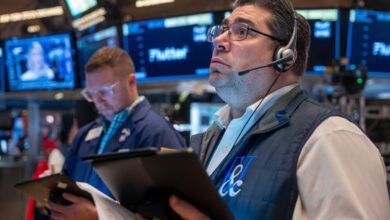3 Charts Show Market Headed for Trouble

Michael Hartnett, Bank of America’s top global strategist, thinks a no-landing scenario is the most-likely outcome for the US economy in the months ahead. That means the labor market would remain strong, but inflation would also stay above the Federal Reserve’s long-term goal of 2%.
While that’s fine for now, Hartnett warns it’s a path that eventually leads to trouble for the economy and stocks. The longer inflation stays elevated, the longer the Fed has to keep policy restrictive or even tighten further, putting the economy at risk of a recession as businesses and consumers slow borrowing and spending.
“We say rising no landing risks = rising hard landing risks,” Hartnett said in an April 11 note. “Monetary tightening resumes (markets now pricing in 15% probability of Fed hike) & contagion risks form from REITs, regional banks, small cap up.”
By many measures, the US economy looks strong. The unemployment rate is at a historically low 3.8% and monthly job growth is steady. Consumer spending, which makes up about two-thirds of the US economy, is also still robust. Household balance sheets are strong, too, with home values at all-time highs and stocks hovering just off of record levels.
But some cracks are beginning to show. Delinquencies on credit card and auto loans are rising, as are layoff announcements. As Hartnett pointed out, small-business optimism is poor, with hiring plans among them at eight-year lows. This is concerning because small businesses make up two-thirds of the US labor market.
Bank of America
Another sign that the economy could be headed for trouble is the sudden drop in high-yield bond prices in recent months. High-yield bonds carry a higher risk of default, so investors demand higher yields in a shaky economic environment. Bond yields rise when their prices drop.
The iShares iBoxx $ High Yield Corporate Bond ETF (HYG) just hit its 200-day moving average, which Hartnett said was “ominous.” The fund’s price dipped below its 200-day moving average in 2020 and 2022, when the economy slowed and stocks underperformed.
Bank of America
This, then, could be a signal that stocks are headed for a downtrend as the S&P 500 sits near all-time highs.
Hartnett said there are other signs, too, that stocks could be in bubble territory. One is that the tech-heavy Nasdaq index is rising at the same time as 10-year Treasury yields, which has historically only happened during bubble or recovery periods.
Bank of America
Are we headed for a hard landing?
Market consensus has shifted from a hard landing in 2022 to a soft landing in 2023 and 2024. But like Hartnett’s view, outlooks may begin to shift more to the bear case in the months ahead, with the Fed likely to leave rates higher for longer.
As recent as December, investors were anticipating that the central bank would make its first rate cut in March. But as jobs data has come in hot and inflation has remained above 3%, the Fed is now expected to cut in July. Some are even ruling out cuts for the entirety of 2024.
“We are firmly in the camp of no rate cuts in 2024,” said Michael Landsberg, chief investment officer at Landsberg Bennett Private Wealth Management, in a memo on Thursday. “While it’s unlikely to occur, there is actually a strong case to be made for the Fed to raise interest rates in 2024 given elevated inflation, low unemployment, high stock prices, bitcoin surging and the re-emergence of IPOs.”
Geopolitical tensions are also high at the moment, as conflicts continue in Ukraine and the Middle East. This has caused oil prices to surge since December, threatening to kick off another bout of global inflation.
Despite geopolitical and monetary policy risks in the post-pandemic era, however, the US economy has so far managed to skirt a recession, proving bearish forecasters wrong.
It may continue to do so. But as Hartnett argues, the longer a no-landing scenario — where inflation stays high — plays out, the higher the risks of recession and a bear market become.
Source link





